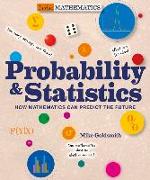- Start
- Probability & Statistics
Probability & Statistics
Angebote / Angebote:
One of the hardest questions that mathematics teachers have to answer is "Why?" Schoolroom sums are crucial in learning the awesome power of mathematics, but they are often a world away from how the knowledge is applied and where it came from. Inside Mathematics: Probability & Statistics is there to fill that gap. What are the chances of that? Mathematics can solve that mystery for you using a set of ideas that grew out of an aristocratic gambler's bafflement at betting on complex dice games. In stepped the mathematical giants of Pierre de Fermat and Blaise Pascal, who worked together to create what is now called probability theory. Gamblers need not rejoice in this powerful theory, it shows that the casino always wins in the end. The ideas of probability have since found many better uses elsewhere. For example, they are at work in the mathematics that describes the quantum world and drives the push for artificial intelligence. The mathematics of chance is involved in understanding systems where myriad data points combine. Statistics is the branch of mathematics that wrangles that data and tames it into meaningful knowledge. It then allows us to get ever better at modeling complex phenomena, from the formation of stars and the path of a hurricane to the rise and fall of the markets.Inside Mathematics: Probability & Statistics introduces the reader to these awesome mathematical powers by telling the stories of who figured them out. They include a cavalry officer hoping to reduce injuries from horse kicks, Charles Darwin's cousin who discovered that we make the best guesses when we work together, and computers that are built to program themselves. Written to engage and enthuse young people, Inside Mathematics shows readers how the ideas of long-dead geniuses have ended up in their homework assignments.Probability & Statistics: How Mathematics Can Predict the Future changes the question from "Why?" to "What's next?"Arranged chronologically to show how ideas in mathematics evolved.
Folgt in ca. 15 Arbeitstagen




